Abstract
The subcellular distribution of the enzymes of de novo pyrimidine nucleotide biosynthesis was investigated in pea (Pisum sativum L. cv Progress No. 9) leaves. Aspartate carbamoyltransferase, the committed step of the pathway, was found to be strictly confined to the chloroplasts. Dihydro-orotase, orotate phosphoribosyl transferase, and orotidine decarboxylase activities were also found only in the plastids. The remaining enzyme of the pathway, dihydroorotate dehydrogenase, was shown to be mitochondrial.
Full text
PDF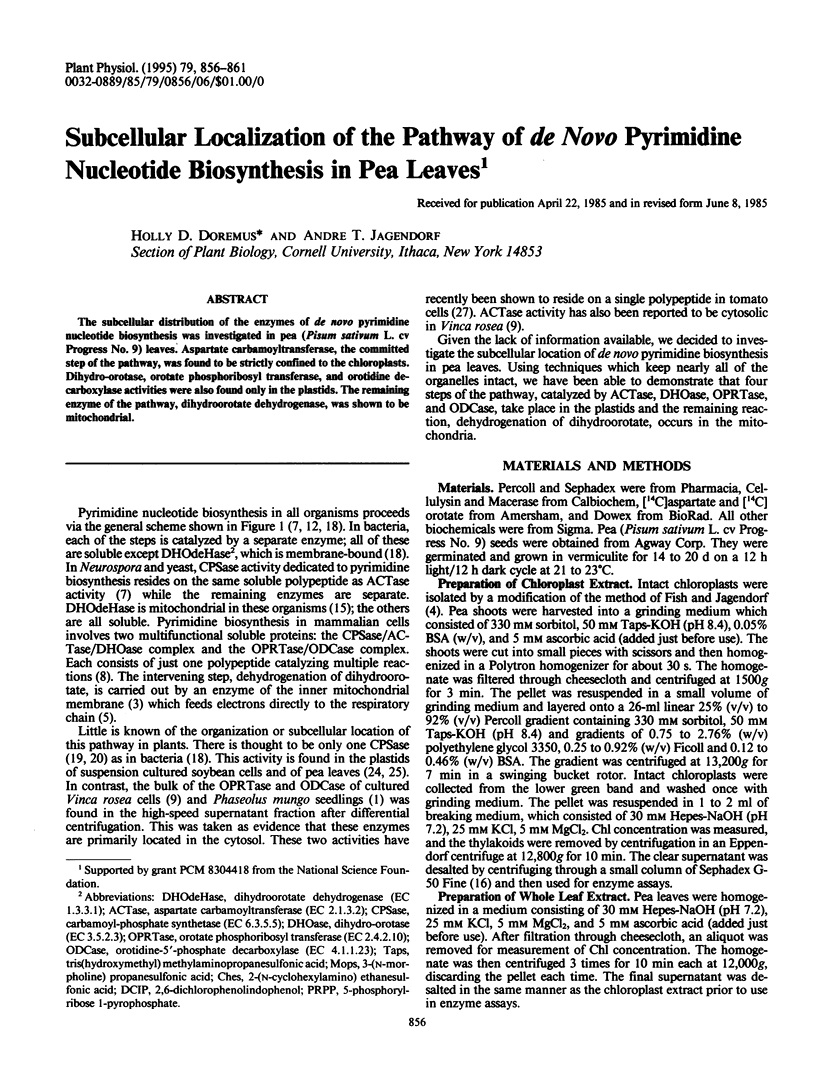
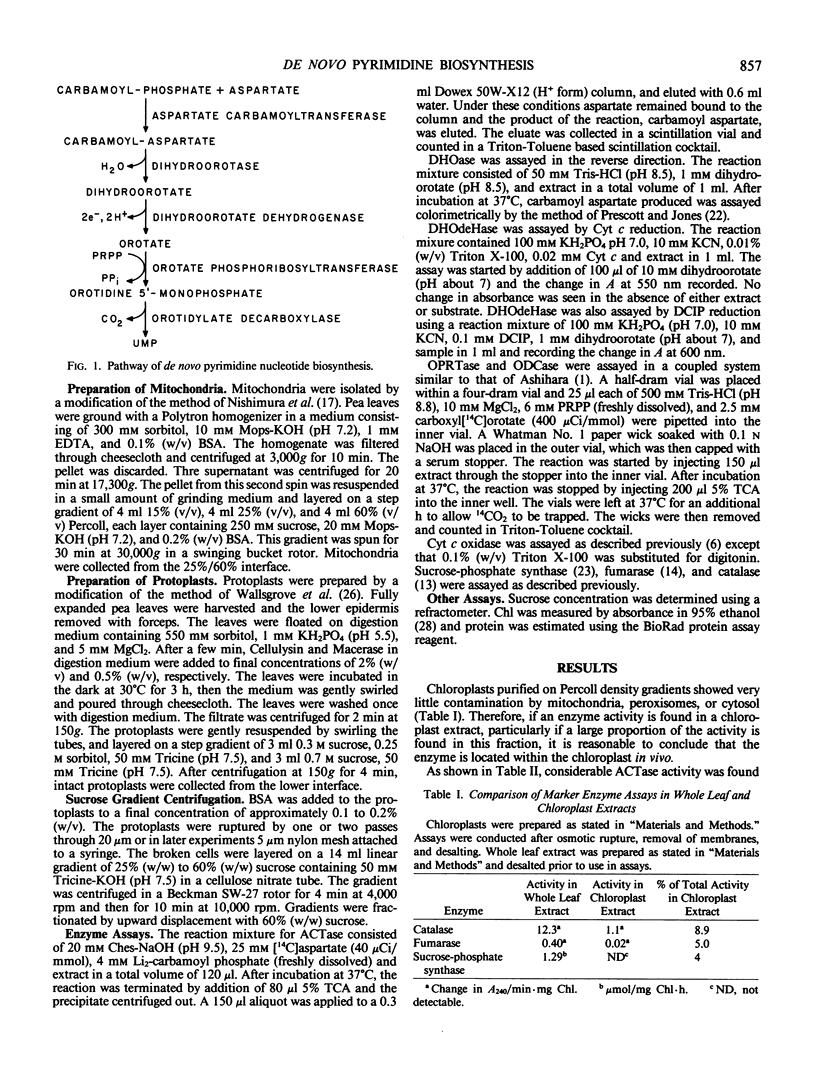
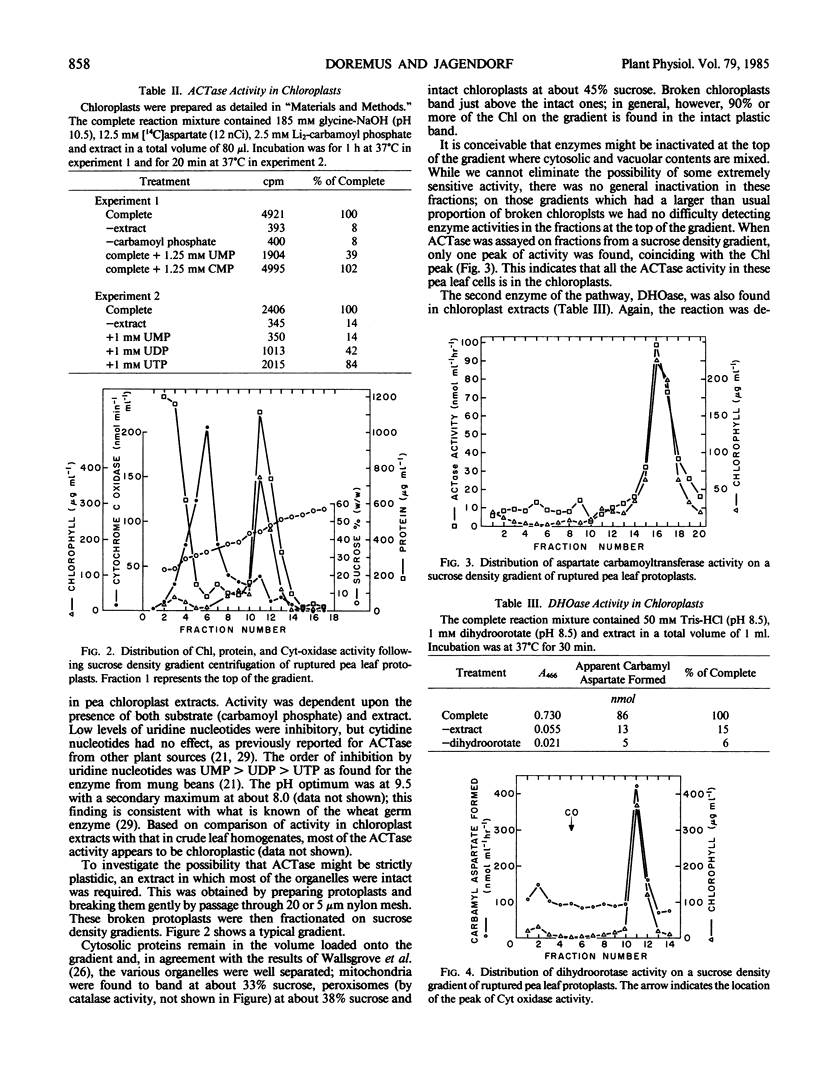
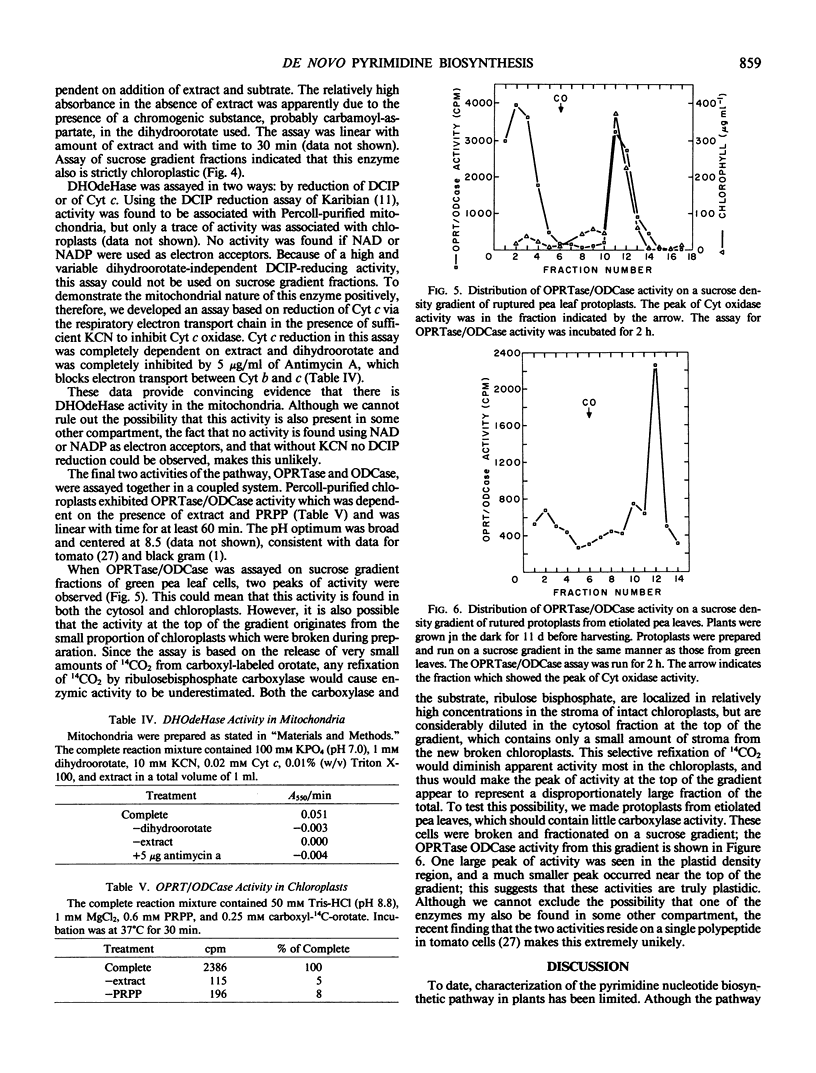
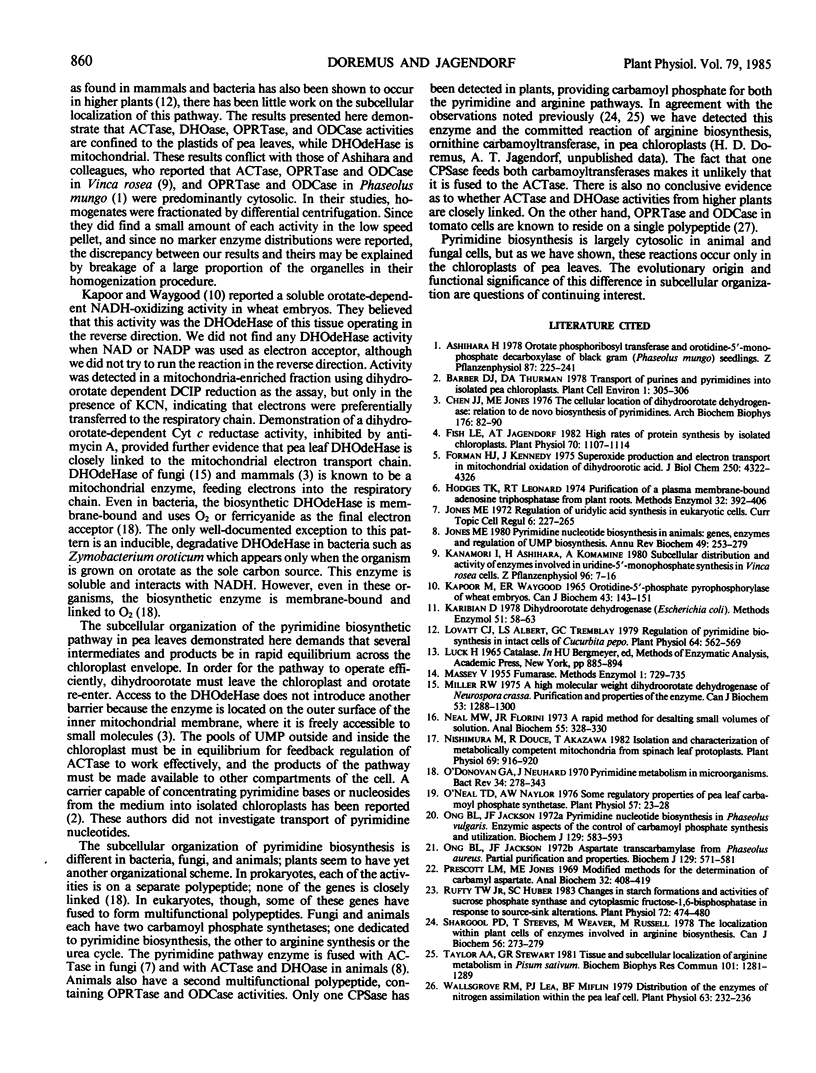

Selected References
These references are in PubMed. This may not be the complete list of references from this article.
- Chen J. J., Jones M. E. The cellular location of dihydroorotate dehydrogenase: relation to de novo biosynthesis of pyrimidines. Arch Biochem Biophys. 1976 Sep;176(1):82–90. doi: 10.1016/0003-9861(76)90143-0. [DOI] [PubMed] [Google Scholar]
- Fish L. E., Jagendorf A. T. High rates of protein synthesis by isolated chloroplasts. Plant Physiol. 1982 Oct;70(4):1107–1114. doi: 10.1104/pp.70.4.1107. [DOI] [PMC free article] [PubMed] [Google Scholar]
- Forman H. J., Kennedy J. Superoxide production and electron transport in mitochondrial oxidation of dihydroorotic acid. J Biol Chem. 1975 Jun 10;250(11):4322–4326. [PubMed] [Google Scholar]
- Hodges T. K., Leonard R. T. Purification of a plasma membrane-bound adenosine triphosphatase from plant roots. Methods Enzymol. 1974;32:392–406. doi: 10.1016/0076-6879(74)32039-3. [DOI] [PubMed] [Google Scholar]
- Jones M. E. Pyrimidine nucleotide biosynthesis in animals: genes, enzymes, and regulation of UMP biosynthesis. Annu Rev Biochem. 1980;49:253–279. doi: 10.1146/annurev.bi.49.070180.001345. [DOI] [PubMed] [Google Scholar]
- KAPOOR M., WAYGOOD E. R. OROTIDINE -5'-PHOSPHATE PYROPHOSPHORYLASE OF WHEAT EMBRYOS. Can J Biochem. 1965 Feb;43:143–151. doi: 10.1139/o65-021. [DOI] [PubMed] [Google Scholar]
- Karibian D. Dihydroorotate dehydrogenase (Escherichia coli). Methods Enzymol. 1978;51:58–63. doi: 10.1016/s0076-6879(78)51010-0. [DOI] [PubMed] [Google Scholar]
- Lovatt C. J., Albert L. S. Regulation of Pyrimidine Biosynthesis in Intact Cells of Cucurbita pepo. Plant Physiol. 1979 Oct;64(4):562–569. doi: 10.1104/pp.64.4.562. [DOI] [PMC free article] [PubMed] [Google Scholar]
- Miller R. W. A high molecular weight dihydro-orotate dehydrogenase of Neurospora crassa. Purification and properties of the enzyme. Can J Biochem. 1975 Dec;53(12):1288–1300. doi: 10.1139/o75-175. [DOI] [PubMed] [Google Scholar]
- Neal M. W., Florini J. R. A rapid method for desalting small volumes of solution. Anal Biochem. 1973 Sep;55(1):328–330. doi: 10.1016/0003-2697(73)90325-4. [DOI] [PubMed] [Google Scholar]
- Nishimura M., Douce R., Akazawa T. Isolation and characterization of metabolically competent mitochondria from spinach leaf protoplasts. Plant Physiol. 1982 Apr;69(4):916–920. doi: 10.1104/pp.69.4.916. [DOI] [PMC free article] [PubMed] [Google Scholar]
- O'Donovan G. A., Neuhard J. Pyrimidine metabolism in microorganisms. Bacteriol Rev. 1970 Sep;34(3):278–343. doi: 10.1128/br.34.3.278-343.1970. [DOI] [PMC free article] [PubMed] [Google Scholar]
- O'neal T. D., Naylor A. W. Some regulatory properties of pea leaf carbamoyl phosphate synthetase. Plant Physiol. 1976 Jan;57(1):23–28. doi: 10.1104/pp.57.1.23. [DOI] [PMC free article] [PubMed] [Google Scholar]
- Ong B. L., Jackson J. F. Aspartate transcarbamoylase from Phaseolus aureus. Partial purification and properties. Biochem J. 1972 Sep;129(3):571–581. doi: 10.1042/bj1290571. [DOI] [PMC free article] [PubMed] [Google Scholar]
- Ong B. L., Jackson J. F. Pyrimidine nucleotide biosynthesis in Phaseolus aureus. Enzymic aspects of the control of carbamoyl phosphate synthesis and utilization. Biochem J. 1972 Sep;129(3):583–593. doi: 10.1042/bj1290583. [DOI] [PMC free article] [PubMed] [Google Scholar]
- Prescott L. M., Jones M. E. Modified methods for the determination of carbamyl aspartate. Anal Biochem. 1969 Dec;32(3):408–419. doi: 10.1016/s0003-2697(69)80008-4. [DOI] [PubMed] [Google Scholar]
- Rufty T. W., Huber S. C. Changes in Starch Formation and Activities of Sucrose Phosphate Synthase and Cytoplasmic Fructose-1,6-bisphosphatase in Response to Source-Sink Alterations. Plant Physiol. 1983 Jun;72(2):474–480. doi: 10.1104/pp.72.2.474. [DOI] [PMC free article] [PubMed] [Google Scholar]
- Shargool P. D., Steeves T., Weaver M., Russell M. The localization within plant cells of enzymes involved in arginine biosynthesis. Can J Biochem. 1978 Apr;56(4):273–279. doi: 10.1139/o78-042. [DOI] [PubMed] [Google Scholar]
- Taylor A. A., Stewart G. R. Tissue and subcellular localization of enzymes of arginine metabolism in Pisum sativum. Biochem Biophys Res Commun. 1981 Aug 31;101(4):1281–1289. doi: 10.1016/0006-291x(81)91586-2. [DOI] [PubMed] [Google Scholar]
- Wallsgrove R. M., Lea P. J., Miflin B. J. Distribution of the Enzymes of Nitrogen Assimilation within the Pea Leaf Cell. Plant Physiol. 1979 Feb;63(2):232–236. doi: 10.1104/pp.63.2.232. [DOI] [PMC free article] [PubMed] [Google Scholar]


